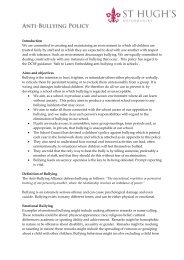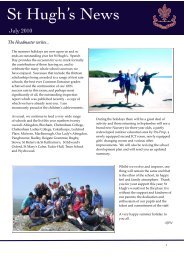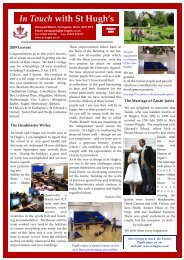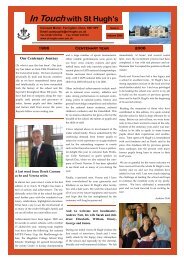HENRY VIII The Dissolution of the Monasteries and the ... - St Hughs
HENRY VIII The Dissolution of the Monasteries and the ... - St Hughs
HENRY VIII The Dissolution of the Monasteries and the ... - St Hughs
You also want an ePaper? Increase the reach of your titles
YUMPU automatically turns print PDFs into web optimized ePapers that Google loves.
monasteries were valued at £100,000 a year from l<strong>and</strong> <strong>and</strong> £25,000 from<br />
o<strong>the</strong>r means.<br />
Later in <strong>the</strong> year, Commissioners (inspectors) visited <strong>the</strong> monasteries to<br />
investigate <strong>the</strong> rumours about idleness, greed <strong>and</strong> bad behaviour.<br />
<strong>The</strong>y reported back that <strong>the</strong> monasteries were 'idle, corrupt <strong>and</strong><br />
useless'.<br />
<strong>The</strong>re were allegations <strong>of</strong> monks fa<strong>the</strong>ring children <strong>and</strong> <strong>of</strong> monks getting<br />
married.<br />
Henry <strong>and</strong> Cromwell now had <strong>the</strong> evidence <strong>the</strong>y needed to act. Some did<br />
however report back that ' religion is well kept <strong>and</strong> observed'.<br />
Cromwell had favourable reports re-written to place more emphasis on<br />
faults.<br />
<strong>Dissolution</strong> <strong>of</strong> <strong>The</strong> Smaller <strong>Monasteries</strong>,1536.<br />
In 1536, Parliament passed an Act that permitted <strong>the</strong> dissolution <strong>of</strong> all<br />
monasteries that had an income <strong>of</strong> less than £200 a year.<br />
376 monasteries were closed.<br />
2000 monks were pensioned <strong>of</strong>f or sent to larger monasteries or<br />
nunneries.<br />
Henry <strong>and</strong> Cromwell were very cautious <strong>and</strong> calculating. <strong>The</strong>y deliberately<br />
chose <strong>the</strong> smaller monasteries first in order to test public opinion <strong>and</strong><br />
because <strong>the</strong>y felt that <strong>the</strong> Tudor treasury was not yet ready to cope with<br />
<strong>the</strong> larger amounts <strong>of</strong> money that would come from <strong>the</strong> larger<br />
monasteries.<br />
<strong>The</strong>re were few complaints <strong>and</strong> <strong>the</strong> closures passed relatively peacefully.<br />
However… not everyone was happy to see <strong>the</strong> monasteries go. Henry faced a<br />
rebellion sparked by <strong>the</strong> closure <strong>of</strong> <strong>the</strong> smaller monasteries. This was called<br />
<strong>the</strong> Pilgrimage <strong>of</strong> Grace.<br />
<strong>The</strong> Pilgrimage <strong>of</strong> Grace, 1536.<br />
In <strong>the</strong> south <strong>and</strong> east <strong>of</strong> Engl<strong>and</strong> little opposition was seen against <strong>the</strong><br />
dissolutions.<br />
However in <strong>the</strong> north things were different.<br />
Two rebellions broke out, one in Lincolnshire <strong>and</strong> one in Yorkshire.<br />
<strong>The</strong> rebellion in Lincolnshire was easily dealt with, because it lacked<br />
leaders <strong>of</strong> any quality. 50 rebels were executed.<br />
However, <strong>the</strong> Yorkshire rebels were a different matter. Robert Aske, a<br />
lawyer <strong>and</strong> l<strong>and</strong>owner managed to get toge<strong>the</strong>r an army <strong>of</strong> 30,000.<br />
<strong>The</strong>y adopted a banner showing <strong>the</strong> five wounds <strong>of</strong> Christ.<br />
He referred to his followers as pilgrims <strong>and</strong> not rebels.






